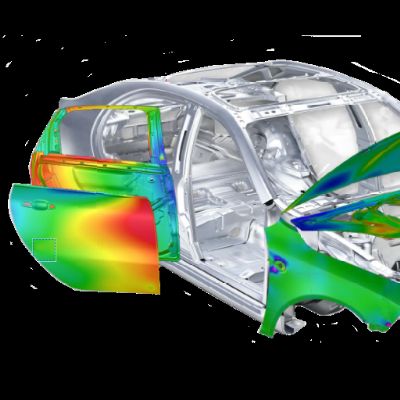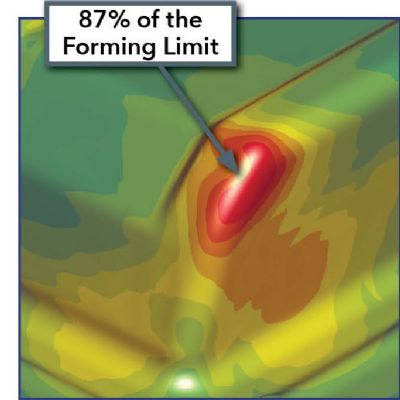Stamping a One-Piece TWB Battery Tray
February 11, 2025Comments
Simulation proves out creation of a tailor-welded blank for an EV battery tray, combining AHSS and lower-strength steel to develop unique blank configurations.
A battery pack typically represents 20 to 25% of the overall weight of an electric vehicle (EV). Though driven by the battery technology selected and the energy-capacity needs of each vehicle model, weight savings clearly can be had in the architecture of the battery enclosure.
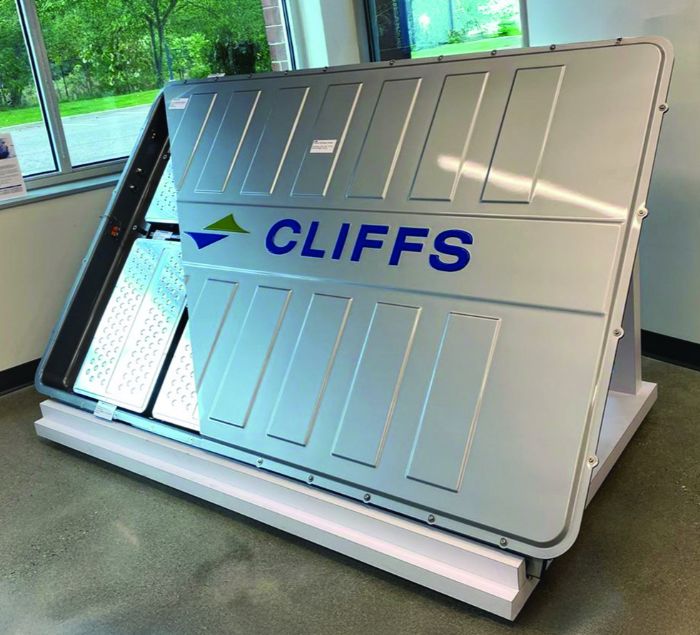 The choice of material, gauge and manufacturing process for enclosure and assembly components represents opportunities to realize weight and cost savings, balanced against the imperative to protect the battery itself.
The choice of material, gauge and manufacturing process for enclosure and assembly components represents opportunities to realize weight and cost savings, balanced against the imperative to protect the battery itself.
In constructing battery trays, vehicle manufacturers have used a variety of material and manufacturing-process combinations, with steel and aluminum dominating applications for the top-cover and bottom-tray components. Due to the high cost and manufacturing difficulty of aluminum battery trays using extrusion, casting and sheet forming, an opportunity exists for a stamped one-piece steel battery tray that eliminates the need for extra under-battery floor protection.
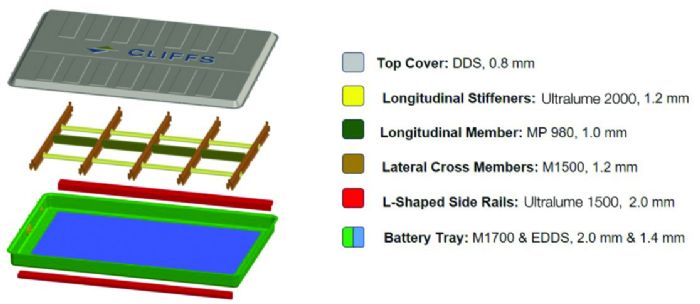 Such a solution has been proposed by Cleveland-Cliffs Inc., using advanced high-strength steel (AHSS) for the bottom of the tray, and a lower-strength steel for the sections that require severe deformation (Fig. 1). Cleveland-Cliffs engineers designed a tray solution around a tailor-welded blank (TWB). For a feasibility study, Isaac Luther and Dawn Stubleski of TWB Co., Monroe, MI, provided the tryout tailor-welded blanks, and QMC-EMI, Livonia, MI, manufactured the prototypes.
Such a solution has been proposed by Cleveland-Cliffs Inc., using advanced high-strength steel (AHSS) for the bottom of the tray, and a lower-strength steel for the sections that require severe deformation (Fig. 1). Cleveland-Cliffs engineers designed a tray solution around a tailor-welded blank (TWB). For a feasibility study, Isaac Luther and Dawn Stubleski of TWB Co., Monroe, MI, provided the tryout tailor-welded blanks, and QMC-EMI, Livonia, MI, manufactured the prototypes.
Lower Strength in Corners
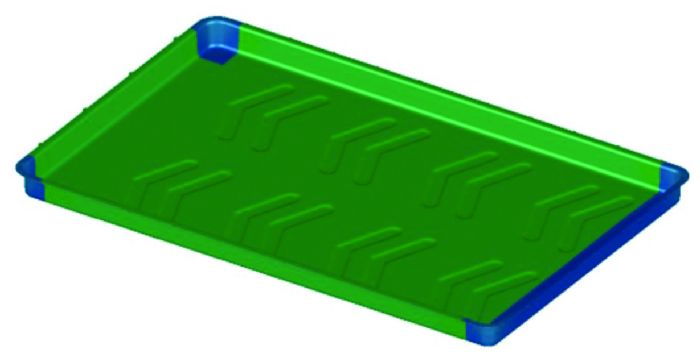 In the initial TWB-tray design, the front and two back corners of the blank consisted of lower-strength, more-formable steel (Fig. 2). To reduce the cost and increase the efficiency of TWB production, engineers also considered using the lower-strength alloy for the rear wall, including the rear two corners, with the rest of the blank—including the front wall and the two sidewalls of the tray—stamped from AHSS.
In the initial TWB-tray design, the front and two back corners of the blank consisted of lower-strength, more-formable steel (Fig. 2). To reduce the cost and increase the efficiency of TWB production, engineers also considered using the lower-strength alloy for the rear wall, including the rear two corners, with the rest of the blank—including the front wall and the two sidewalls of the tray—stamped from AHSS.






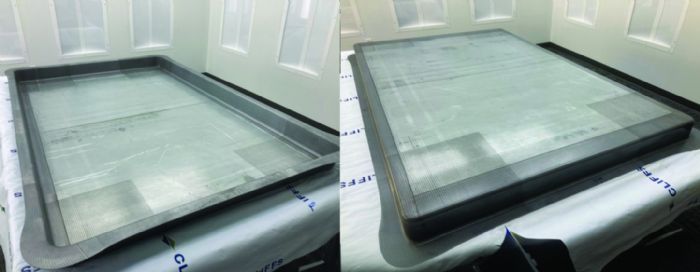 Engineers performed several iterations of material selection and TWB design, coupled with stamping-feasibility and structural-analysis simulations performed using AutoForm simulation software. Structural analyses confirmed that the full battery enclosure and AHSS tray—type M1500 or M1700—with mild steel in the corners and rear wall, would surpass ballistic underfloor-impact side-pole crash requirements.
Engineers performed several iterations of material selection and TWB design, coupled with stamping-feasibility and structural-analysis simulations performed using AutoForm simulation software. Structural analyses confirmed that the full battery enclosure and AHSS tray—type M1500 or M1700—with mild steel in the corners and rear wall, would surpass ballistic underfloor-impact side-pole crash requirements. 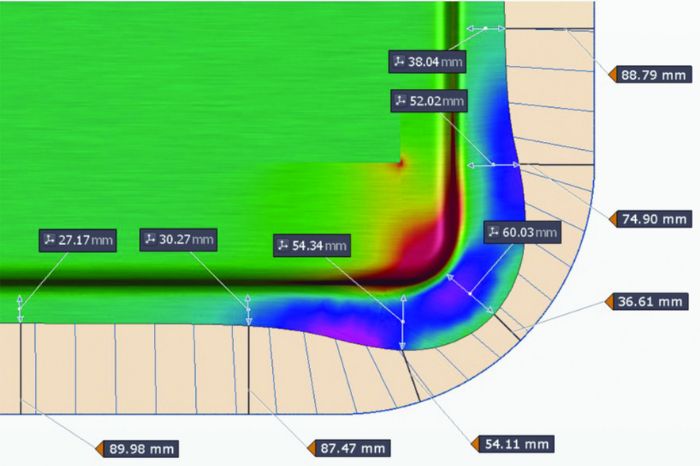 However, AutoForm simulation of the TWB stamping showed severe springback and twisting of material after releasing the stamped tray from the die, a finding validated through physical prototyping. To meet stringent leak-test requirements for battery enclosures, the tray flange must exhibit a flatness variation of no more than ±1.5 mm over its entire length—not possible due to the severe springback.
However, AutoForm simulation of the TWB stamping showed severe springback and twisting of material after releasing the stamped tray from the die, a finding validated through physical prototyping. To meet stringent leak-test requirements for battery enclosures, the tray flange must exhibit a flatness variation of no more than ±1.5 mm over its entire length—not possible due to the severe springback.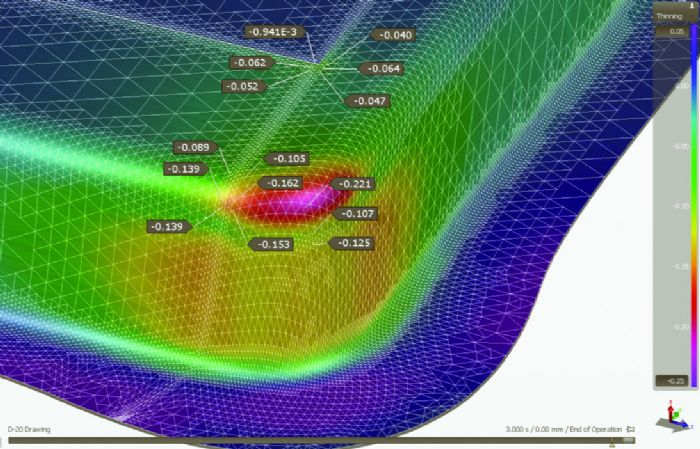 Undertaking further TWB-design optimization, Cleveland-Cliffs engineers developed a design with AHSS located in the flat bottom, attached to mild steel all around, including the sidewalls and tray corners, similar to a hashtag-shaped (#) configuration (Fig. 3). The AHSS provides required underfloor protection, and with the AHSS section undergoing very little deformation during stamping, weld-line movement is minimal. This, in turn, ensures integrity of the laser-weld line, enabling it to remain leakproof.
Undertaking further TWB-design optimization, Cleveland-Cliffs engineers developed a design with AHSS located in the flat bottom, attached to mild steel all around, including the sidewalls and tray corners, similar to a hashtag-shaped (#) configuration (Fig. 3). The AHSS provides required underfloor protection, and with the AHSS section undergoing very little deformation during stamping, weld-line movement is minimal. This, in turn, ensures integrity of the laser-weld line, enabling it to remain leakproof.  The battery tray, a critical component in the full EV battery enclosure, carries significant responsibility for the safety and integrity of a full battery package, and provides a vital opportunity for weight and cost savings. Taking advantage of this innovative design, courtesy of Cleveland-Cliffs’ material expertise and AutoForm’s simulation capability, the project team was able to complete the bill of materials for the proposed full battery enclosure and produce full-scale prototypes.
The battery tray, a critical component in the full EV battery enclosure, carries significant responsibility for the safety and integrity of a full battery package, and provides a vital opportunity for weight and cost savings. Taking advantage of this innovative design, courtesy of Cleveland-Cliffs’ material expertise and AutoForm’s simulation capability, the project team was able to complete the bill of materials for the proposed full battery enclosure and produce full-scale prototypes. 
